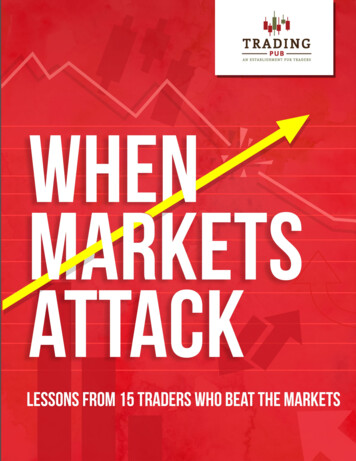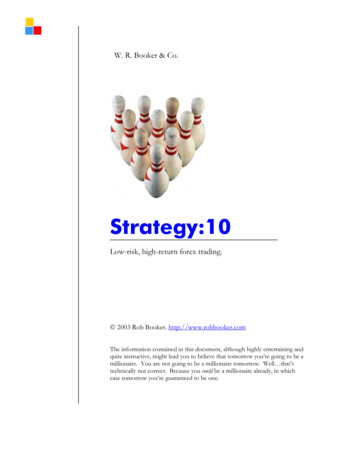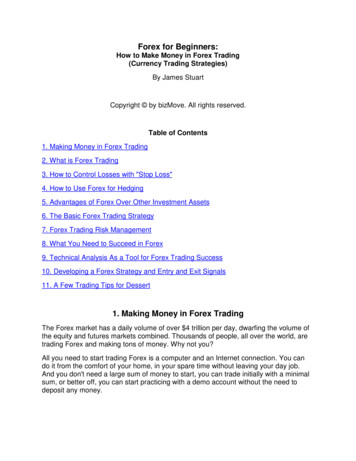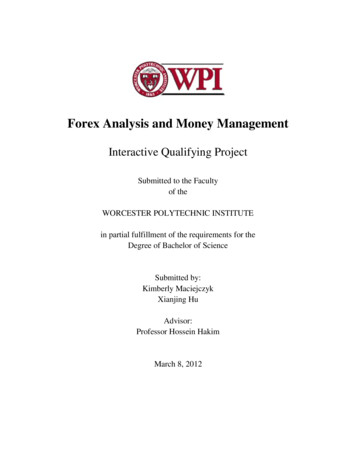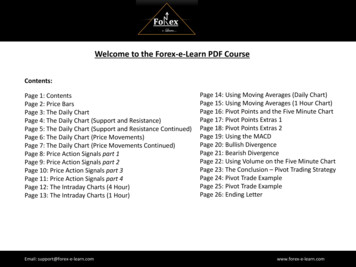
Transcription
Welcome to the Forex-e-Learn PDF CourseContents:Page 1: ContentsPage 2: Price BarsPage 3: The Daily ChartPage 4: The Daily Chart (Support and Resistance)Page 5: The Daily Chart (Support and Resistance Continued)Page 6: The Daily Chart (Price Movements)Page 7: The Daily Chart (Price Movements Continued)Page 8: Price Action Signals part 1Page 9: Price Action Signals part 2Page 10: Price Action Signals part 3Page 11: Price Action Signals part 4Page 12: The Intraday Charts (4 Hour)Page 13: The Intraday Charts (1 Hour)Email: support@forex-e-learn.comPage 14: Using Moving Averages (Daily Chart)Page 15: Using Moving Averages (1 Hour Chart)Page 16: Pivot Points and the Five Minute ChartPage 17: Pivot Points Extras 1Page 18: Pivot Points Extras 2Page 19: Using the MACDPage 20: Bullish DivergencePage 21: Bearish DivergencePage 22: Using Volume on the Five Minute ChartPage 23: The Conclusion – Pivot Trading StrategyPage 24: Pivot Trade ExamplePage 25: Pivot Trade ExamplePage 26: Ending Letterwww.forex-e-learn.com
Module 1 – Price BarsKey Notes: Each Price Bar contains four components, they are the ‘OPEN/HIGH/LOW/CLOSE’. When the market closes HIGHER than it opens, the bar is GREEN. When the market closes LOWER than it opens, the bar is RED. When the market closes at exactly the same price that it opened, the bar is either colourless or a colour set byyour trading WLOWLOW
Module 2 – The Daily ChartKey Notes: The initial thing to check is where price is at the moment, is it testing any areas of support or resistance? Make sure you identify which movement price is currently in (Movement A or Movement B), this is crucial to determining your long/short bias. Movement A is always in the direction of the major trend and is the bigger move, Movement B is the correction. Check to see where price closed in relation to the high/low as it shows how strong the buyers/sellers are. Support or resistance is only valid when price has tested the area at least 2 or 3 times.Valid DowntrendValid Uptrend If price is making lowerhighs and lower lows, thetrend is considered down. If price is making higherhighs and higher lows, thetrend is considered up.
Module 2 – The Daily Chart(Support and Resistance)Valid Support – price has tested theline at least twiceValid Resistance– price has tested the lineat least twice
Module 2 – The Daily Chart(Support and Resistance)Classic example of where previoussupport becomes new resistanceValid Support – Price tested at least 2 timesThis is NOT a valid support area because price has only tested it once. Wecall this area a reaction zone. We still mark it with a horizontal line butwe are aware that price is likely to go through it a lot easier (as proventwo weeks later).
Module 2 – The Daily Chart(Price Movements) Movement A is always with the dominant trend/Movement B is the correction ( In a downtrend, when the professionals are selling,the price is moving down. They then need to take their profits and that causes Movement B) In a downtrend, when the daily chart produces a bar that has closed HIGHER than it opened, this signifies that the Movement A isweakening and Movement B is about to start We must be aware what Movement price is going through so that we can trade in that direction, this also applies to the 1 hour chartAAAAABBBB
Module 2 – The Daily Chart(Price Movements) The example below shows a very steep upward trend. What you will find is that when there is a very steep uptrend,Movement B will only last for a short time period (1-3 days) It is recommended that you trade with the trend and pay close attention to the 1 Hour and 5 Minute charts to determinewhat movement the market is going to take in such a dominant, steep uptrend (i.e. using the example below during theLondon Trading Session from 8am onwards, if price breaks through the Pivot Point and heads towards Support 1, this is asign that Movement B has started)BBBBAABBBAAAAA
Module 2 Extras(Price Action Signals)In the Forex market, ‘Price Action Signals’ refer to visual setups that occur at key levels of support and resistance which cancause the market to change direction. If we can understand the signals, they can be enormously profitable when used correctly.Below are some of the most important ‘Price Action Signals’ that we need to look for when trading (especially on the DailyChart).THE PIN BARThe Pin Bar shows that priceopened, was pushed lower butthe buyers came back into themarket and pushed price up.(Bullish Signal)This is still a valid Pin Bar eventhough it closed lower than itopened. The tail connotes that thesellers still tried to push price lowerbut the buyers were able to moveprice higher.THE PIN BAR REVERSALThe Pin Bar Reversal shows thatprice opened, was pushedhigher by buyers, but the sellerscame back into the market andpushed price lower.(Bearish Signal)This is still a valid Pin Bar Reversaleven though it closed higher than itopened. The tail connotes that thebuyers still tried to push pricehigher but the sellers were able tomove price lower.
Module 2 Extras(Price Action Signals)THE BULLISH ENGULFING BARThe Bullish EngulfingBar is a bar that isbigger than at leastone of its previousbars. It engulfs the lowand the high of theprevious bar.THE BEARISH ENGULFING BARThe Bearish Engulfing Baris a bar that is biggerthan at least one of itsprevious bars. It engulfsthe low and the high ofthe previous bar.
Module 2 Extras(Price Action Signals)Please Note: These price action signals are only valid at key support or resistance areas and are reversal signals. That means that thepreceding trend must be different to the Price Action Signal. E.g. we must have a downward trend that is in front of a BullishEngulfing Bar/or we must have an upward trend that occurs before a Pin Bar Reversal. In addition, price needs to CONFIRM that theyare valid by taking out the low/high of the signal bar. For example, if we had a bullish Pin Bar but we did not take out the high – thesignal is considered as weak. On the other hand, if we had a Bearish Engulfing Bar and the next bar took out the low – this is a strongsignal that the sellers are gaining control of the market.BULLISH DUAL BAR REVERSALThe Bullish Dual Bar Reversal is similar to a BullishEngulfing Bar but the only difference is that it onlybreaks the high – not the high and low. For thesignal to be valid, the most recent bar needs toreach a much higher high than it’s previous bar.BEARISH DUAL BAR REVERSALThe Bearish Dual Bar Reversal is similar to a BearishEngulfing Bar but the only difference is that it onlybreaks the low– not the high and low. For the signalto be valid, the most recent bar needs to reach amuch lower low than it’s previous bar. These workbest on the DAILY CHART.
Module 2 Extras(Price Action Signals)The final Price Action Signal that you will see is called an ‘Inside Bar Pattern’. This means that a price bar has been formed, but theone after is INSIDE the previous (i.e. it did not break the high or low). These setups are the most strongest on the DAILY CHART. I donot use them on the 1 Hour Chart or the 4 Hour Chart. They are almost like a coiled spring and the next bar will usually be anexplosive move.BULLISH INSIDE BARThis is a bullish formation as price wasunable to make a lower low – it wassupported by buyers.BEARISH INSIDE BARThis is a bearish formation as price wasunable to make a higher high – it wasresisted by sellers.
Module 3 – The Intraday Charts(4 Hour)Key Notes: We utilise the 4 hour chart to give us extra conviction for entering a trade. Once we have checked the Daily, One Hour and 5 Minute – the 4hour is checked to confirm our bias The best time to look at the 4 hour chart is the 6am bar (it takes into account some of the European Session), the 10am bar (it takes intoaccount the first two hours of the London Session) and the 2pm bar (this takes into account the middle of the London Session and the startingof the US session) We can also study the 4 hour chart in the form of price movements, but we don't need to study it as closely as the Daily chart as far asopen,high,low and close is concerned Only take price action signals if they are off of a key support or resistance level confirmed by the Daily chartNext day 10am bar that shows a lotof buying through the start of theLondon Session (Movement A afterthe previous pullback)It is important not to trade just because of a signal on the4 hour chart. Once you have seen the move on the 4 hourchart, it has usually happened on the lower time frames.This is why you see the market reversing so often afterthe big buyer bars/seller bars.Prime example of the 6am bar – bullish engulfing pattern thatcauses buying throughout the rest of the trading day
Module 3 – The Intraday Charts(1 Hour) The 1 hour chart is important for determining which ‘Movement’ we are in on an intraday basis We do not need to pay close attention to the open,high,low and close or any price action signals unless it is at a keysupport/resistance level from the daily The most important bars are the 7am, 8am 9am and 10am bars as they show us what the London Session has started to do withthe currency pair (remember London is the centre of the Forex Market and they dictate the daily sentiment) The next bars to pay particular attention to is the 2pm and the 3pm bars because they show the first few hours of the US Sessionand the afternoon London trading7am bar on the EUR/USD caused heavyselling into the London Open (am)A8am bar – one hour into London’strading. Prime example why we don'tlook at price action on the one hourchart as this is a pin bar and youwould expect price to move upwardson a higher time frame. It doesn'there and continues fallingthroughout the trading day.ABB
Module 4 – Using Moving AveragesKey Notes: We only use exponential moving averages as they add more weight to recent prices We use two moving averages 50EMA and 200EMA as these are the most closely watched by Professional Institutions If price is above the 50EMA and 200EMA the trend is considered up When price penetrates the 50EMA for the second time and closes through it, it is likely to head towards the 200EMA. It is a sign that the trend isweakening and the Professional traders are taking their profits If price is testing the 50EMA or the 200EMA on the DAILY CHART, we stay out of the market If the moving averages are close together and moving sideways – it suggests that you are in a ranging market and there is a lack of direction Look for the currency pairs that trend and respect the moving averages. i.e. if price pulls back towards the 50EMA and then pushes away When the moving averages cross over to the upside or downside it suggests that we are entering a new trend, but do not enter just because this hashappened. We use the moving averages as a guide to tell us when we want to be entering or exiting the market. I.e. in the daily downtrend examplebelow, Professional Traders sell when price retraces back towards the 50EMADoesn’t quite reach it here, butis a valid, ‘BEARISH DUAL BARREVERSAL’ so we can trade thenext day.
Module 4 – Using Moving Averages(1 Hour Chart Examples)BAPrice finding buyers initiating‘Movement A’ around the50EMA.Price piercing through the50EMA 1st time doesn’t meanmuch. When it breaks throughthe second time however itshows you that the trend isweakening. Usually price headstowards the 200EMA andtouches it.Price finding support at50EMA. Prime examplewhy we trade with thesmall bars before thebig move happens.WE DO NOT TRADE WHEN THE MOVING AVERAGES ARE MOVING SIDEWAYS OR IF THEY ARE CLOSE TOGETHER NO TREND.
Module 5 – Pivot Points and The Five Minute ChartKey Notes: Pivot Points are used by Professional Forex Traders all around the World Pivot Points tell us where the market is likely to find Support or Resistance We only want to be trading from the Pivot Point to minimize our risk We do not want to enter a position if price is more than 15 pips away from the Pivot Point If price is above the Pivot Point, we want to be buying If price is below the Pivot Point, we want to be selling The most critical time to enter or exit a trade using Pivot Points is during the first hour of the London Session (8am – 9am GMT). London is thecentre of all Foreign Exchange and they will give us the direction of the session by showing us if price is going to break through or move away fromthe Pivot Point Unless the daily chart is in a steep up/downtrend and there is room until the next daily support/resistance line – we don’t really want to be tradingfrom R1 or S1 When price breaks through the Pivot Point to the upside or downside, it is likely to move against you for some time before continuing in yourdirection. This happens because the Market Makers and Institutions would test the level to confirm that the move is strong enough to propel price Pivot Points are CRITICAL in determining our daily bias. If we are in a downtrend for example, and by 9am London have broken the Pivot Point tothe upside, it is likely that throughout the day price will continue up and we will start a ‘Movement B’ (correction phase) Pivot Points give you the earlier indication as to what price is going to do next. Ideally as traders in the Forex markets we only want to be takingbetween 20-25 pips to start with. This is because the average ranges and price movements between Pivot, Point 5 and S1/R1 show that price islikely to fall/rise at least 20 pips before reversing. Professional Traders understand this and take their profits off of the table when their target hasbeen hit. Amateur Traders on the other hand either exit the market too early or stay in it for too long and then the market turns against them We have our TAKE PROFIT 2 to 5 pips in front of either R1 or S1 to cater for the spread we pay to enter the trade The 50EMA is used on the 5min chart for us to determine if price has the ability to push itself a
Welcome to the Forex-e-Learn PDF Course Contents: Page 1: Contents Page 2: Price Bars Page 3: The Daily Chart Page 4: The Daily Chart (Support and Resistance) Page 5: The Daily Chart (Support and Resistance Continued) Page 6: The Daily Chart (Price Movements) Page 7: The Daily Chart (Price Movements Continued) Page 8: Price Action Signals part 1 Page 9: Price Action Signals part 2 Page


